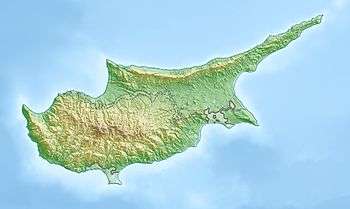Galata, Cyprus
Galata (Greek: Γαλάτα) is a village in the Solea valley, located about 60 km west of the capital Nicosia, at an altitude of 620 m in the Troodos Mountains of Cyprus. It is a popular summer tourist destination (especially among locals) for its cooler climate in the summer months.[2] It is also well known on the island for its fruit produce. In Galata there is Panagia tis Podithou (Greek: Παναγία της Ποδίθου), church, which is a UNESCO World Heritage Site along with nine other Painted Churches in the Troödos Region.
Galata | |
|---|---|
| Γαλάτα (Greek) | |
Panagia tis Podhithou on UNESCO list | |
 Galata Panagia tis Podhithou on UNESCO list | |
| Coordinates: 34°59′0″N 32°53′0″E | |
| Country | |
| District | Nicosia District |
| Population (2001[1]) | |
| • Total | 653 |
| Time zone | UTC+2 (EET) |
| • Summer (DST) | UTC+3 (EEST) |
| Postal code | 2827 |
| Website | http://www.galata.org.cy |
Name of village and history
According to Greek mythology, Cyprus was the first land that Aphrodite set foot on; where Pygmalion begged her to let him be with the statue that he created in her image. Aphrodite brought the statue to life and Pygmalion married Galatea.
According to one version of villages name first settlers came from Galatia in Asia Minor.[3] According to other version village was populated with shepherds who sold milk, that is milkmens (in Greek galataes).[3] Leontios Machairas in his Chronicle mentioned that Galata belongs to feud of king after 1196.[3] From his chronicles could be concluded that during Lusignan Period Galata belonged to de Giblet family.[3] Demetrios de Coron, senior officer of House of Lusignan, after fall of Lusignans retired close to Galata, where he built the monastery Panagia tis Podithou in 1502.[3] Russian traveler and pilgrim Vasyl Hryhorovych-Barskyi visited Galata and wrote 1735.[3] Edward Stafford of the English Consulate of the island lived in Galata in 1691. In 1910, Galata opened its first hotel.

Village of balconies
Galata is built on banks of river Klarios, that crosses the Solea Valley. Galata is almost merged with nearby Kakopetria. Traditional houses have wooden balconies and still there are many balconies in village. They had two floors and wooden balcony was extension of second floor looking at the main road.[3] The Museum of Folkloric Art was established in 1990.[3] Galata had four watermills, and watermill of "Kyrillos" is still operational.[3]
Churches
In Galata there is Panagia tis Podithou (Greek: Παναγία της Ποδίθου), church from 1502, which is a UNESCO World Heritage Site along with nine other Painted Churches in the Troödos Region.[4] Church Panagia Theotokos/Archangel Michael from 1514. is located 100 m near Panagia tis Podithou.[3] Small church Agios Sozomenos from 1513 is in middle of village near big main Galata church Panagia Odegetria (Virgin Mary guiding), built in 1930.[3] Agia Paraskevi and Agios Georgios are small 16th century churches on road between Galata and Kakopetria.[3] Agios Nicolaos is small church from the 15th century at western entrance of Galata.[3]
References
- Statistical Service of the Republic of Cyprus, 2001 Population Census, MS Excel document
- Dubin, Marc; Morris, Damien (2002-01-01). Cyprus. Rough Guides. ISBN 9781858288635.
- Galata
- UNESCO list
